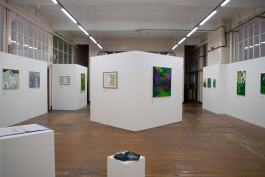
Gladly Beyond install shot
The seven artists represented in Gladly Beyond, a group show by members of Ten Obstructions at Rogue Studios in Openshaw, Manchester, may at first appear to have little in common, working in media ranging from collage, painting and textiles to sound art and speculative science fiction.
Initially, the grouping was formed through involvement in bOlder, a programme initiated by Castlefield Gallery in Manchester, aimed at supporting and providing opportunities targeted at artists in Greater Manchester over the age of fifty. Since the initial scheme has finished, the artists have continued not just to exhibit together under the name Ten Obstructions (the seven artists exhibiting in Gladly Beyond are drawn from a wider cohort of ten artists), but to act as an informal yet supportive network offering critique, inspiration and a platform to bounce ideas off one another.
A previous group show, In the Making, held at Salford Museum and Art Gallery earlier in 2023, prompted a deep engagement by each artist with place, considering journeys, people, geology and landmarks in the city.
Gladly Beyond is concerned less explicitly with the exhibition’s immediate locale, taking its title from a love poem by ee cummings, yet a strong sense still emerges of each artist’s place in the world, their relationship with the places they work, live, visit and travel through, and their relationship with others.
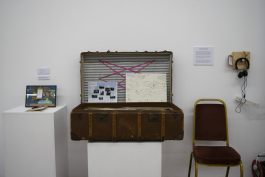
Gladly Beyond install shot
Sabrina Fuller’s mixed-media installation ‘The Power of Fragility’ is based around the fantastical ‘VU Manc School of Interplanetary Studies’, which brings attention to the displacement caused by climate change. Directly confronting the viewer, Fuller asks the visitor to both explore and add to an imagined narrative in which those able to do so have left the earth to build a new society, leaving those left behind in a post-apocalyptic scenario. The experience is enveloping and multi-sensory, experienced visually, through touch and auditorily through headphones. From within a high-note frequency, overlaid with repeated female voices in multiple languages, a clear message emerges: “We are the ones who remain to care for the planet.” An open suitcase further captures the imagination, inviting the viewer directly into this narrative by asking them to rifle through notebooks, diaries, journals, maps, photographs and correspondence and to write messages of advice, support and hope. From these artefacts, which include collages populated with shadowy figures, we piece together fragments of a story that is both familiar and alien to us, to which we feel simultaneously close and distant. Fuller questions how people are seen and represented, asking us to consider those who are excluded from mainstream society, whose lives are on the margins or ‘other’ to our own, and to speculate what another world might be like and how we might care for one another.

Gladly Beyond install shot
The work of Sarah Feinmann, a studioholder at Rogue, is concerned with more everyday change and transition, both in relation to movement through space and the built environment. Presenting a body of work called ‘On the Periphery’, Feinmann often documents journeys though the city, with a particular focus on edgelands and other overlooked spaces that are not typically noticed or cared for. Some of the work featured in Gladly Beyond draws on a train journey to Rogue Studios, which sits directly adjacent to a suburban trainline that leaves the city through its nondescript industrial outskirts. Drawing inspiration from close-ups of utilitarian structures and infrastructure, such as doorways and railway sidings, as well as the effect of light, Feinmann’s collage and acrylic paint-based work is led by colour, shape and texture. The paintwork is suggestive of familiar urban textures in the city, a patchwork that is subject to a constant process of ad hoc additions, subtractions and repairs. Vertical brushstrokes in shades of black and grey suggest the crinkle of corrugated iron. Elsewhere the viewer might think they recognise the patchy corrosion of rusty metal, the grimy circles left by a cloth smeared across a surface in a semblance of cleaning, the lingering remnants of stickers and posters half-heartedly ripped down, or the droplets of rain that accumulate on a non-porous surface. Instead of seeking to literally represent or depict a place, the overall result is abstraction and reduction. Rather than drawing attention to the anonymous functionality of buildings we regularly see, but barely notice, because we don’t fully know what they are or comprehend their function, the effect is to blur our surroundings and make them somehow both indistinct and unrecognisable yet relatable to our lived experience of the city.
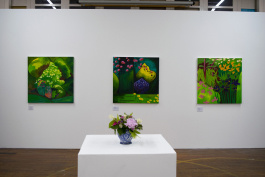
Gladly Beyond install shot
In contrast to the sense of entropy encapsulated in Feinmann’s work, Jane Fairhurst’s series of oil paintings, ‘Garden Meditations’, portrays spaces that are carefully managed and cultivated and require ongoing care and upkeep. Fairhurst revels in the formal and decorative qualities of mythical and historic gardens, simplifying shape, form and colour to highlight outline and detail in a way that’s reminiscent of stage sets or boldly patterned textile designs. In their use of vivid colour, Fairhurst’s paintings bring to mind Paul Gauguin’s atmospheric depictions of landscapes in Tahiti, while the foregrounding of objects in the landscape, such as hedges and bushes, evokes both historic, man-made monuments such as standing circles and Barbara Hepworth’s interest in the formal and sculptural qualities of stone. In ‘Garden Meditations’, Fairhurst appears to cycle through time, capturing the way in which the liminal space of the garden changes and grows according to the time of day, the light, the weather and the season, from the soft edges created by the half-light of dusk to the stark contrasts prevalent in the intense light of late winter.

Gladly Beyond install shot
Ian Vines, likewise, plays with shape, form and imagery. In ‘Beyond the Horizon’, Vines’ mixed media assemblages, combining 3D elements with 2D photographs, cleverly place tools of measurement (rulers, a model of the solar system, weights) against photos of places (an amusement park, a beach, a Hong Kong ferry), and deconstruct these tools. Vines’ images are often inverted, suggesting that time is bending and the world turning upside down. In doing so, they ask us to look again at what we are seeing and to question our ideas of height, scale and distance.
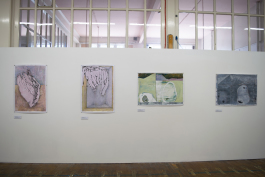
Gladly Beyond install shot
Christopher Rainham’s work, ‘Wings Become Waves’, asks us to both look closely and take a longer view of landscape. Rainham’s densely worked surfaces, thick with mark-making, bring to mind laborious processes of archaeological excavation: he asks us to slow down our way of looking and suggests a way of looking at landscape that is deeply rooted in long historical processes and contexts. Rainham’s work is also grounded in narrative and storytelling. This is present both in fragments of messages (look closely and you can make out the words “Slow with tar”) as well as anthropomorphic and suggestive forms. A pair of angel wings resemble a rock formation, an evocative reference to a 1975 archaeological dig in Denmark which unearthed a still-born child from the Mesolithic era buried in a protective swan’s wing.
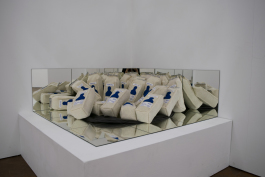
Gladly Beyond install shot
Claire Hignett’s work, ‘Not in Safekeeping: Missing’, similarly suggests care and protection, yet grounds the exhibition explicitly in the current political and historical context. During the exhibition period, Hignett has been physically present in the space, publicly stitching and adding to a poignant collection of around 200 stitched felt milk bottles, each one marking the disappearance of a child asylum seeker from the supposed care of the British state, in hotels on the south coast. The soft, comforting tactility of the textile work is juxtaposed with a ring binder resembling an institutional file, bringing to mind official documentation (each record is marked ‘n/k’, to stand for ‘not known’) and hard facts: the uniformity of both suggests anonymity. Hignett’s emotionally charged installation shows how individual lives come up against the apparatus of the state, questioning the methods and motivations of those processes that are designed to safeguard the vulnerable and highlighting the lack of care from the state towards a marginalised group of people. Displayed on a mirrored surface, it feels natural to reflect on our own, personal attitudes towards migration and asylum.

Gladly Beyond install shot
Maya Chowdhry’s interactive piece, ‘temp/o~reality’, is again a work of contrasts, juxtaposing natural and technological time-keeping and highlighting the changing ways we conceptualise and keep time. The work is experienced as a set of instructions accessed by scanning a QR code – which is set against a background of a dandelion clock, taking us back to childhood games and looser, freer conceptions of time. After using our mobile phone to access the work, our device acts as a stop watch, imbuing our task with a sense of urgency. Chowdry asks us to pay attention to place by stopping, slowing down and focusing on a particular aspect of our environment, such as a bicycle – features of place that are at the same time general and specific.
If there seems to be an emphasis on place and landscape, there also remains something deeply human about the preoccupations of the artists exhibiting in Gladly Beyond. In different ways, this disparate group of artists explore our relationships with the planet, places and with people. Going beyond any arbitrary grouping based on age or geography, together they raise pertinent questions about hierarchies of value, responsibility and care, and the ways in which these change over time and according to our position in society.
Commissioned summer 2023
Gladly Beyond was at Rogue Studios, Manchester, 3 June – 31 July 2023
Photos: Matylda Augustynek

Gladly Beyond install shot
The seven artists represented in Gladly Beyond, a group show by members of Ten Obstructions at Rogue Studios in Openshaw, Manchester, may at first appear to have little in common, working in media ranging from collage, painting and textiles to sound art and speculative science fiction.
Initially, the grouping was formed through involvement in bOlder, a programme initiated by Castlefield Gallery in Manchester, aimed at supporting and providing opportunities targeted at artists in Greater Manchester over the age of fifty. Since the initial scheme has finished, the artists have continued not just to exhibit together under the name Ten Obstructions (the seven artists exhibiting in Gladly Beyond are drawn from a wider cohort of ten artists), but to act as an informal yet supportive network offering critique, inspiration and a platform to bounce ideas off one another.
A previous group show, In the Making, held at Salford Museum and Art Gallery earlier in 2023, prompted a deep engagement by each artist with place, considering journeys, people, geology and landmarks in the city.
Gladly Beyond is concerned less explicitly with the exhibition’s immediate locale, taking its title from a love poem by ee cummings, yet a strong sense still emerges of each artist’s place in the world, their relationship with the places they work, live, visit and travel through, and their relationship with others.

Gladly Beyond install shot
Sabrina Fuller’s mixed-media installation ‘The Power of Fragility’ is based around the fantastical ‘VU Manc School of Interplanetary Studies’, which brings attention to the displacement caused by climate change. Directly confronting the viewer, Fuller asks the visitor to both explore and add to an imagined narrative in which those able to do so have left the earth to build a new society, leaving those left behind in a post-apocalyptic scenario. The experience is enveloping and multi-sensory, experienced visually, through touch and auditorily through headphones. From within a high-note frequency, overlaid with repeated female voices in multiple languages, a clear message emerges: “We are the ones who remain to care for the planet.” An open suitcase further captures the imagination, inviting the viewer directly into this narrative by asking them to rifle through notebooks, diaries, journals, maps, photographs and correspondence and to write messages of advice, support and hope. From these artefacts, which include collages populated with shadowy figures, we piece together fragments of a story that is both familiar and alien to us, to which we feel simultaneously close and distant. Fuller questions how people are seen and represented, asking us to consider those who are excluded from mainstream society, whose lives are on the margins or ‘other’ to our own, and to speculate what another world might be like and how we might care for one another.

Gladly Beyond install shot
The work of Sarah Feinmann, a studioholder at Rogue, is concerned with more everyday change and transition, both in relation to movement through space and the built environment. Presenting a body of work called ‘On the Periphery’, Feinmann often documents journeys though the city, with a particular focus on edgelands and other overlooked spaces that are not typically noticed or cared for. Some of the work featured in Gladly Beyond draws on a train journey to Rogue Studios, which sits directly adjacent to a suburban trainline that leaves the city through its nondescript industrial outskirts. Drawing inspiration from close-ups of utilitarian structures and infrastructure, such as doorways and railway sidings, as well as the effect of light, Feinmann’s collage and acrylic paint-based work is led by colour, shape and texture. The paintwork is suggestive of familiar urban textures in the city, a patchwork that is subject to a constant process of ad hoc additions, subtractions and repairs. Vertical brushstrokes in shades of black and grey suggest the crinkle of corrugated iron. Elsewhere the viewer might think they recognise the patchy corrosion of rusty metal, the grimy circles left by a cloth smeared across a surface in a semblance of cleaning, the lingering remnants of stickers and posters half-heartedly ripped down, or the droplets of rain that accumulate on a non-porous surface. Instead of seeking to literally represent or depict a place, the overall result is abstraction and reduction. Rather than drawing attention to the anonymous functionality of buildings we regularly see, but barely notice, because we don’t fully know what they are or comprehend their function, the effect is to blur our surroundings and make them somehow both indistinct and unrecognisable yet relatable to our lived experience of the city.

Gladly Beyond install shot
In contrast to the sense of entropy encapsulated in Feinmann’s work, Jane Fairhurst’s series of oil paintings, ‘Garden Meditations’, portrays spaces that are carefully managed and cultivated and require ongoing care and upkeep. Fairhurst revels in the formal and decorative qualities of mythical and historic gardens, simplifying shape, form and colour to highlight outline and detail in a way that’s reminiscent of stage sets or boldly patterned textile designs. In their use of vivid colour, Fairhurst’s paintings bring to mind Paul Gauguin’s atmospheric depictions of landscapes in Tahiti, while the foregrounding of objects in the landscape, such as hedges and bushes, evokes both historic, man-made monuments such as standing circles and Barbara Hepworth’s interest in the formal and sculptural qualities of stone. In ‘Garden Meditations’, Fairhurst appears to cycle through time, capturing the way in which the liminal space of the garden changes and grows according to the time of day, the light, the weather and the season, from the soft edges created by the half-light of dusk to the stark contrasts prevalent in the intense light of late winter.

Gladly Beyond install shot
Ian Vines, likewise, plays with shape, form and imagery. In ‘Beyond the Horizon’, Vines’ mixed media assemblages, combining 3D elements with 2D photographs, cleverly place tools of measurement (rulers, a model of the solar system, weights) against photos of places (an amusement park, a beach, a Hong Kong ferry), and deconstruct these tools. Vines’ images are often inverted, suggesting that time is bending and the world turning upside down. In doing so, they ask us to look again at what we are seeing and to question our ideas of height, scale and distance.

Gladly Beyond install shot
Christopher Rainham’s work, ‘Wings Become Waves’, asks us to both look closely and take a longer view of landscape. Rainham’s densely worked surfaces, thick with mark-making, bring to mind laborious processes of archaeological excavation: he asks us to slow down our way of looking and suggests a way of looking at landscape that is deeply rooted in long historical processes and contexts. Rainham’s work is also grounded in narrative and storytelling. This is present both in fragments of messages (look closely and you can make out the words “Slow with tar”) as well as anthropomorphic and suggestive forms. A pair of angel wings resemble a rock formation, an evocative reference to a 1975 archaeological dig in Denmark which unearthed a still-born child from the Mesolithic era buried in a protective swan’s wing.

Gladly Beyond install shot
Claire Hignett’s work, ‘Not in Safekeeping: Missing’, similarly suggests care and protection, yet grounds the exhibition explicitly in the current political and historical context. During the exhibition period, Hignett has been physically present in the space, publicly stitching and adding to a poignant collection of around 200 stitched felt milk bottles, each one marking the disappearance of a child asylum seeker from the supposed care of the British state, in hotels on the south coast. The soft, comforting tactility of the textile work is juxtaposed with a ring binder resembling an institutional file, bringing to mind official documentation (each record is marked ‘n/k’, to stand for ‘not known’) and hard facts: the uniformity of both suggests anonymity. Hignett’s emotionally charged installation shows how individual lives come up against the apparatus of the state, questioning the methods and motivations of those processes that are designed to safeguard the vulnerable and highlighting the lack of care from the state towards a marginalised group of people. Displayed on a mirrored surface, it feels natural to reflect on our own, personal attitudes towards migration and asylum.

Gladly Beyond install shot
Maya Chowdhry’s interactive piece, ‘temp/o~reality’, is again a work of contrasts, juxtaposing natural and technological time-keeping and highlighting the changing ways we conceptualise and keep time. The work is experienced as a set of instructions accessed by scanning a QR code – which is set against a background of a dandelion clock, taking us back to childhood games and looser, freer conceptions of time. After using our mobile phone to access the work, our device acts as a stop watch, imbuing our task with a sense of urgency. Chowdry asks us to pay attention to place by stopping, slowing down and focusing on a particular aspect of our environment, such as a bicycle – features of place that are at the same time general and specific.
If there seems to be an emphasis on place and landscape, there also remains something deeply human about the preoccupations of the artists exhibiting in Gladly Beyond. In different ways, this disparate group of artists explore our relationships with the planet, places and with people. Going beyond any arbitrary grouping based on age or geography, together they raise pertinent questions about hierarchies of value, responsibility and care, and the ways in which these change over time and according to our position in society.
Commissioned summer 2023
Gladly Beyond was at Rogue Studios, Manchester, 3 June – 31 July 2023
Photos: Matylda Augustynek
⬑
⬑